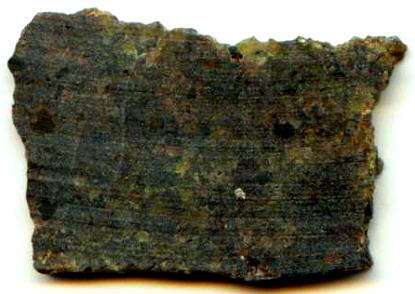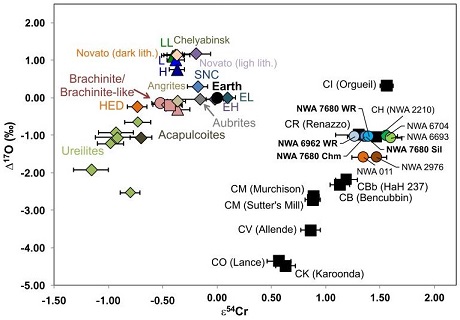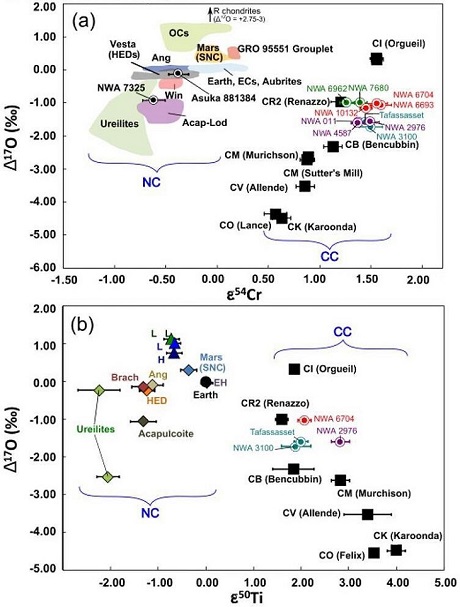AchondriteAn achondrite is a type of stony meteorite whose precursor was of chondritic origin and experienced metamorphic and igneous processes. They have a planetary or differentiated asteroidal origin where the chondritic parent body reached a sufficient size that through heating due to radioactive decay of 26Al (aluminum isotope) and gravitational Click on Term to Read More, ungroupedModifying term used to describe meteorites that are mineralogically and/or chemically unique and defy classification into the group or sub-group they most closely resemble. Some examples include Ungrouped Achondrite (achondrite-ung), Ungrouped Chondrite (chondrite-ung), Ungrouped Iron (iron-ung), and Ungrouped Carbonaceous (C-ung). Click on Term to Read More
(brachinite-like geochemistryStudy of the chemical composition of Earth and other planets, chemical processes and reactions that govern the composition of rocks and soils, and the cycles of matter and energy that transport Earth's chemical components in time and space. Click on Term to Read More, ferroan,
CR-like isotopic composition)

Found 2011
no coordinates recorded
A single brown-colored
meteoriteWork in progress. A solid natural object reaching a planet’s surface from interplanetary space. Solid portion of a meteoroid that survives its fall to Earth, or some other body. Meteorites are classified as stony meteorites, iron meteorites, and stony-iron meteorites. These groups are further divided according to their mineralogy and Click on Term to Read More weighing 59.8 g was found in Northwest Africa and subsequently purchased by M. Farmer from a Moroccan dealer at the 2011 Denver
MineralInorganic substance that is (1) naturally occurring (but does not have a biologic or man-made origin) and formed by physical (not biological) forces with a (2) defined chemical composition of limited variation, has a (3) distinctive set of of physical properties including being a solid, and has a (4) homogeneous Click on Term to Read More Show. A sample was analyzed at the University of Washington in Seattle (A. Irving and S. Kuehner) and NWA 6962 was classified as an ungrouped achondrite having some geochemical affinities to the brachinite group, although
olivineGroup of silicate minerals, (Mg,Fe)2SiO4, with the compositional endpoints of forsterite (Mg2SiO4) and fayalite (Fe2SiO4). Olivine is commonly found in all chondrites within both the matrix and chondrules, achondrites including most primitive achondrites and some evolved achondrites, in pallasites as large yellow-green crystals (brown when terrestrialized), in the silicate portion Click on Term to Read More in this meteorite is significantly more ferroan.
The interior appearance of NWA 6962 has been described as an aggregate of yellowish-brown olivine crystals containing melt inclusions composed of sodic
plagioclaseAlso referred to as the plagioclase feldspar series. Plagioclase is a common rock-forming series of feldspar minerals containing a continuous solid solution of calcium and sodium: (Na1-x,Cax)(Alx+1,Si1-x)Si2O8 where x = 0 to 1. The Ca-rich end-member is called anorthite (pure anorthite has formula: CaAl2Si2O8) and the Na-rich end-member is albite Click on Term to Read More +
chromiteBrownish-black oxide of chromium and iron (Cr-Fe oxide), Cr2FeO4, found in many meteorite groups. Click on Term to Read More + Ni-free
metalElement that readily forms cations and has metallic bonds; sometimes said to be similar to a cation in a cloud of electrons. The metals are one of the three groups of elements as distinguished by their ionization and bonding properties, along with the metalloids and nonmetals. A diagonal line drawn Click on Term to Read More, along with an
interstitialTerm applied to ions or atoms occupying sites between lattice points. Click on Term to Read More Na-rich
silicateThe most abundant group of minerals in Earth's crust, the structure of silicates are dominated by the silica tetrahedron, SiO44-, with metal ions occurring between tetrahedra). The mesodesmic bonds of the silicon tetrahedron allow extensive polymerization and silicates are classified according to the amount of linking that occurs between the determined by Raman spectra to be nepheline or
tridymiteSilica group mineral in which the tetrahedra occur in sheets. Tetrahedra alternately point up or down to share oxygen with tetrahedra of other sheets, forming six-sided rings perpendicular the sheets. Tridymite has a fairly open structure and accommodates Na+, K+ and Ca2+; charge balance is achieved by Al3+ ↔ Si4+.. In addition, scattered grains of Ti-poor Al-bearing chromite are present along with minor clinopyroxene (
augiteHigh-Ca clinopyroxene, (Ca,Mg,Fe)SiO3, that occurs in many igneous rocks, particularly those of basaltic composition. In order to be considered augite, the clinopyroxene must contain 20 to 45 mol % of calcium (Wo20 - 45). An important and unique Martian meteorite is NWA 8159, that has been classified as an augite basalt. Click on Term to Read More), merrillite, and fluorapatite, as well as sparse abundances of FeNi-metal and FeS grains.
Although NWA 6962 shows some mineralogical similarities to brachinites, its geochemical characteristics are inconsistent with a genetic relationship;
e.g., Fe-enriched silicates, Fe/Mn ratios, and O-isotopic values (Dunlap
et al., 2015). Oxygen-isotope values for NWA 6962 were ascertained (R. Tanaka, Okayama University, Japan), and the plot is near the CCAM line near the resolved fields for ureilites and the acapulcoite–
lodraniteRare type of primitive achondrite named after the Lodran meteorite that fell in Pakistan in 1868. Initially, lodranites were grouped with the stony-iron meteorites because they contain silicates (olivine, orthopyroxene, and minor plagioclase) and Fe-Ni metal in nearly equal proportions. However, since discovery of the closely related acapulcoite group, lodranites Click on Term to Read More clan (see the
oxygen three-isotope plot). Notably, the O-isotopic values for NWA 6962 are very similar to those determined by N. Banerjee
et al. (Western University, Canada) for the 124 g NWA 7680 (see the
oxygen three-isotope plot). Since these two meteorites were both purchased in 2011 and have similar O-isotopic values, bulk compositions, and geochemical constitutions, it is considered that they are genetically related (Hyde
et al., 2013, 2017).
Additional studies of NWA 6962/7680 by Hyde
et al. (2017), including major, minor, and trace elemental compositions, led to the conclusion that there is no obvious relationship to either the ureilites or the acapulcoite–lodranite clan. Since NWA 6962/7680 plot near the CCAM line and show similarities to some CM and CV clasts thought to originate from the interior of these asteroids, it is considered that NWA 6962/7680 could also derive from the deep interior of a primitive
carbonaceous chondriteCarbonaceous chondrites represent the most primitive rock samples of our solar system. This rare (less than 5% of all meteorite falls) class of meteorites are a time capsule from the earliest days in the formation of our solar system. They are divided into the following compositional groups that, other than Click on Term to Read More parent bodyThe body from which a meteorite or meteoroid was derived prior to its ejection. Some parent bodies were destroyed early in the formation of our Solar System, while others like the asteroid 4-Vesta and Mars are still observable today. Click on Term to Read More.
Further studies of samples from both NWA 6962 and 7680 were conducted by Sanborn
et al. (2018). Utilizing a coupled Δ
17O
vs. ε
54Cr diagram, they demonstrated that NWA 6962/7680 plots within the CR/CH carbonaceous
chondriteChondrites are the most common meteorites accounting for ~84% of falls. Chondrites are comprised mostly of Fe- and Mg-bearing silicate minerals (found in both chondrules and fine grained matrix), reduced Fe/Ni metal (found in various states like large blebs, small grains and/or even chondrule rims), and various refractory inclusions (such Click on Term to Read More field represented by CR2 Renazzo and CH3 NWA 2210 (see diagram below). This plot is also proximate to that of the ungrouped carbonaceous achondrites
NWA 6704 and pairings and
NWA 011 and pairings, which suggests that a genetic relationship exists among them. Chromium
vs. OxygenElement that makes up 20.95 vol. % of the Earth's atmosphere at ground level, 89 wt. % of seawater and 46.6 wt. % (94 vol. %) of Earth's crust. It appears to be the third most abundant element in the universe (after H and He), but has an abundance only Click on Term to Read More IsotopeOne of two or more atoms with the same atomic number (Z), but different mass (A). For example, hydrogen has three isotopes: 1H, 2H (deuterium), and 3H (tritium). Different isotopes of a given element have different numbers of neutrons in the nucleus. Click on Term to Read More Plot
 click on image for a magnified view
click on image for a magnified view
Diagram credit: Sanborn
et al., 49th LPSC,
#2296 (2018) Moreover, Sanborn
et al. (2018) determined an absolute Mn–Cr age (anchored to D’Orbigny) for NWA 6962/7680 of 4.56376 (±0.00176) b.y., which is concordant with the ages calculated for NWA 6704/6693 and the NWA 011 pairing group. It has been proposed by many investigators that a large (~400 km diameter) differentiated CR parent body formed in the early history of the
Solar SystemThe Sun and set of objects orbiting around it including planets and their moons and rings, asteroids, comets, and meteoroids. and subsequently experienced a collisional disruption. For more information pertaining to this scenario, see the LPSC abstract
”Primitive’ and igneous achondrites related to the large and differentiated CR parent body’ by Bunch
et al. (2005), the MetSoc abstract
‘Tafassasset and Primitive Achondrites: Records of Planetary Differentiation’ by Nehru
et al. (2014), and the LPSC abstract
‘Collisional Disruption of a Layered, Differentiated CR Parent Body Containing Metamorphic and Igneous Lithologies Overlain by a Chondrite Veneer’ by Irving
et al. (2014).
Huyskens
et al. (2019) derived and compiled chronological data from multiple dating systems for four different achondrite parent bodies that accreted in the CR reservoir, comprising the pairing groups of NWA 011/2976/4587, NWA 6704/6693/10132, Tafassasset/NWA 3100, and NWA 6962/7680. They determined that each of these parent bodies accreted and differentiated early in Solar
SystemDefinable part of the universe that can be open, closed, or isolated. An open system exchanges both matter and energy with its surroundings. A closed system can only exchange energy with its surroundings; it has walls through which heat can pass. An isolated system cannot exchange energy or matter with history and over a relatively short timespan ~4.5637 to 4.5624 b.y. ago. Each of these CR-like objects have Cr- and Ti-isotopic compositions that when coupled to the O-isotopic compositions plot in distinct locations (see diagrams below). Notably, the CR2 chondrite Renazzo plots nearest to NWA 6962/7680 in O–Cr space, but no comparable Ti isotope data is yet available.
17O vs. ε54Cr and ε50Ti for CR Carbonaceous Achondrites  click on photo for a magnified view
click on photo for a magnified view
Diagrams credit: Huyskens
et al., 50th LPSC,
#2736 (2019)
Northwest Africa 6962 shows evidence for low shock and a low degree of terrestrial weathering. The specimen of NWA 6962 shown above is a 0.547 g slice.









